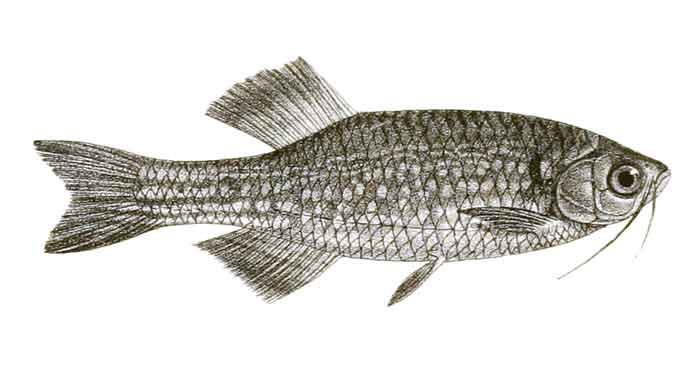
Superregnum: Eukaryota
Cladus: Unikonta
Cladus: Opisthokonta
Cladus: Holozoa
Regnum: Animalia
Subregnum: Eumetazoa
Cladus: Bilateria
Cladus: Nephrozoa
Superphylum: Deuterostomia
Phylum: Chordata
Subphylum: Vertebrata
Infraphylum: Gnathostomata
Megaclassis: Osteichthyes
Superclassis/Classis: Actinopterygii
Classis/Subclassis: Actinopteri
Subclassis/Infraclassis: Neopterygii
Infraclassis: Teleostei
Megacohors: Osteoglossocephalai
Supercohors: Clupeocephala
Cohors: Otomorpha
Subcohors: Ostariophysi
Sectio: Otophysa
Ordo: Cypriniformes
Subordo: Cyprinoidei
Familia: Danionidae
Subfamilia: Danioninae
Genus: Danio
Species: Danio dangila
Name
Danio dangila (Hamilton, 1822)
No types known.
Type locality: Mountain streams of Mongher, Behar [Bihar], India.
Synonyms
Cyprinus dangila Hamilton, 1822
Perilampus reticulatus McClelland, 1839
References
Hamilton, F. 1822. An account of the fishes found in the river Ganges and its branches. Archibald Constable & Co., Hurst, Robinson & Co. Pp. i–vii + 1–405, Pls. 1–39. BHL Reference page.
Kullander, S.O. 2015. Taxonomy of chain Danio, an Indo-Myanmar species assemblage, with descriptions of four new species (Teleostei: Cyprinidae). Ichthyological Exploration of Freshwaters 25(4): 357–380, 5 figs., 7 tabs. PDF. Reference page.
Danio dangila, the moustached danio, is a freshwater fish, and is the largest of the true Danio species at up to (6 in) long. Its name is from its particularly long barbels. It is sometimes kept in aquariums, where its relatively passive nature allows it to be housed in a community tank.[2]
Details
Adults individuals can grow up to 15 cm (6 inches) and have a lifespan of 3 to 5 years.[3]
Habitat
This fish inhabits the Ganga-Brahmaputra drainage system in Bihar, northern Bengal, northeast India and Nepal, as well as being recorded in Umroi Stream and rheophilic torrent in India. Its habitat is clear mountain streams, where specimens have been taken from the rocks and stones which compose the riverbed.[4] the moustached danio prefers soft water with a relatively neutral pH.[2]
Threats
Though this fish is small and so rarely eaten, there have been concerns on its harvesting for the pet trade. Captive breeding has been attempted, succeeding in ICAR; this method has apparently also been replicated by fish farmers. The IUCN has considered the harvesting to be a potential cause of decline, which may be supported by population surveys, but more surveys must be conducted in order to confirm the effects. If captive breeding cannot fuel the stock needed for the aquarium trade, then it may have to be reassessed, potentially moving it to a higher threat category.[4]
References
Vishwanath, W. (2010). "Danio dangila". IUCN Red List of Threatened Species. 2010: e.T166536A6231727. doi:10.2305/IUCN.UK.2010-4.RLTS.T166536A6231727.en. Retrieved 19 November 2021.
"Moustached Danio – Danio dangila – Tropical Fish Planet". Retrieved 2021-01-19.
Danio dangila on FishBase
Himalayas)), Waikhom Vishwanath (Manipur University (Eastern (2010-01-22). "IUCN Red List of Threatened Species: Danio dangila". IUCN Red List of Threatened Species. Retrieved 2021-01-19.
Retrieved from "http://en.wikipedia.org/"
All text is available under the terms of the GNU Free Documentation License

